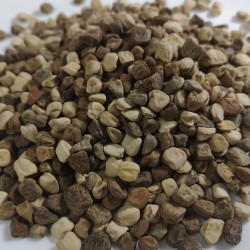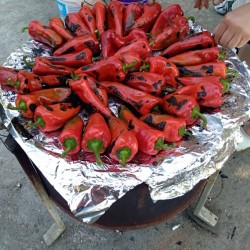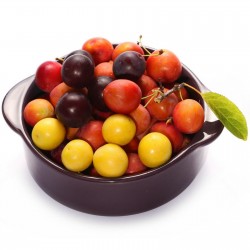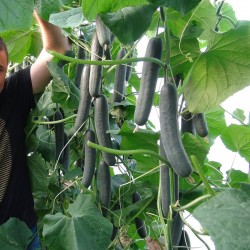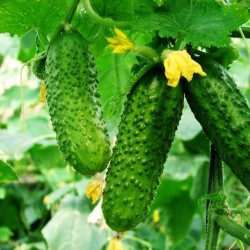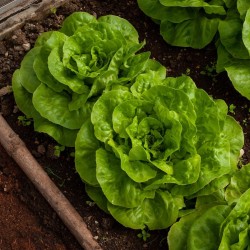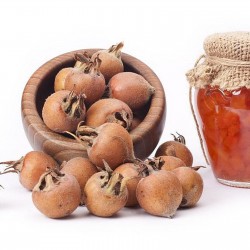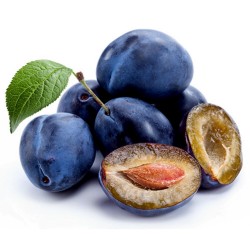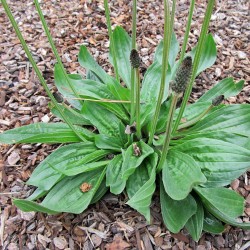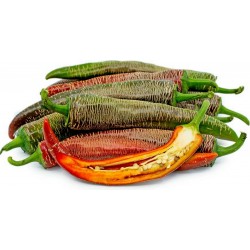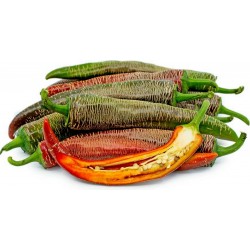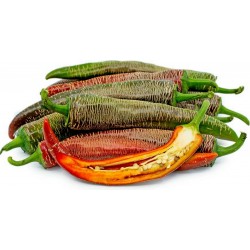Seeds Gallery Com,
5/
5
<p></p>
<h2><strong>Semena Jitrocel kopinatý (Plantago lanceolata)</strong><br><span style="color: #f80000;" class=""><strong>Cena za balení 560 (1 g) semen.</strong></span></h2>
<p><b>Jitrocel kopinatý</b><span> </span>(<i>Plantago lanceolata</i>) je<span> </span>trsnatá<span> </span>vytrvalá<span> </span>rostlina<span> </span>z čeledi<span> </span>jitrocelovitých<span> </span>(<i>Plantaginaceae</i>), charakteristická typickou růžicí přízemních<span> </span>listů, ze které vyrůstá několik<span> </span>stvolů.<sup id="cite_ref-celysvet_1-0" class="reference">[1]</sup><span> </span>Rostlina je v dnešní době hojně rozšířena ve velké části světa i na území<span> </span>Česka, kde se vyskytuje na<span> </span>polích, u cest či na<span> </span>loukách.<sup id="cite_ref-celysvet_1-1" class="reference">[1]</sup><span> </span>Jedná se o léčivou bylinu, působí proti<span> </span>kašli<span> </span>a má protizánětlivé a<span> </span>antibiotické účinky, které jsou způsobeny přítomností<span> </span>glykosidu<span> </span>jménem<span> </span>aukubin, čehož se využívá k léčbě vředových chorob<span> </span>žaludku,<span> </span>dvanáctníků<span> </span>i tlustého střeva.<sup id="cite_ref-kvetanacr_2-0" class="reference">[2]</sup></p>
<p>Mimo jitrocel kopinatý roste na území ČR asi 6 dalších druhů jitrocelů,<sup id="cite_ref-Kubát_3-0" class="reference">[3]</sup><span> </span>z nichž nejznámější je<span> </span>jitrocel prostřední<span> </span>(<i>Plantago media</i>) a<span> </span>jitrocel větší<span> </span>(<i>Plantago major</i>). Oba dva druhy mají ale menší přítomnost léčivých látek.</p>
<p>Jitrocel se může dožívat až 12 let, během kterých dorůstá do velikosti několika desítek centimetrů. Rozmnožuje se jak pomocí semen, tak i vegetativně.</p>
<h2 style="color: #000000; font-size: 1.5em;"><span class="mw-headline" id="Lidové_názvy">Lidové názvy</span></h2>
<p>Pro jitrocel kopinatý existuje řada lidových názvů jako<span> </span><i>babka</i>,<span> </span><i>celníček</i>,<span> </span><i>hojílek</i>,<span> </span><i>hítrocíl</i>,<span> </span><i>myší ocas</i>,<span> </span><i>myší ouško</i>,<span> </span><i>ranocel</i><sup id="cite_ref-delsi_4-0" class="reference">[4]</sup><span> </span>či<span> </span><i>volský jazyk</i>,<sup id="cite_ref-volskyjazyk_5-0" class="reference">[5]</sup><span> </span><i>beraní jazyk</i>,<span> </span><i>psí jazyk</i>,<span> </span><i>olověný jazyk</i>,<span> </span><i>čelník</i><span> </span>a<span> </span><i>svalník</i>.</p>
<h2 style="color: #000000; font-size: 1.5em;"><span class="mw-headline" id="Popis">Popis</span></h2>
<p style="color: #202122; font-size: 14px;">Jitrocel kopinatý je přibližně 7–30 cm,<sup id="cite_ref-Kubát_3-1" class="reference">[3]</sup><span> </span>řidčeji až 60 cm<sup id="cite_ref-Flora_of_Pakistan_6-0" class="reference">[6]</sup><span> </span>vysoká vytrvalá bylina s krátkým a zpravidla větveným<span> </span>oddenkem<sup id="cite_ref-Květena_ČR_7-0" class="reference">[7]</sup><span> </span>Listy<span> </span>jsou uspořádány většinou do několika přízemních růžic, jsou vystoupavé až vzpřímené, asi 10–25, zřídka až 40 cm dlouhé<sup id="cite_ref-Flora_of_Pakistan_6-1" class="reference">[6]</sup><span> </span>a asi 0,5–3 (zřídka až 4,5) cm široké,<sup id="cite_ref-Květena_ČR_7-1" class="reference">[7]</sup><span> </span>jednoduché, na bázi se znenáhla zužují v<span> </span>řapík.<sup id="cite_ref-Květena_ČR_7-2" class="reference">[7]</sup><span> </span>Čepel<span> </span>je na vrcholu špičatá, celokrajná a nebo oddáleně zubatá. Listem prochází 3–5 (řidčeji až 7) souběžně uspořádaných<span> </span>žil. Žíly jsou více viditelné ze spodní strany listu.<sup id="cite_ref-delsi_4-1" class="reference">[4]</sup><span> </span>Z růžice vyrůstají i podélně pětihranné<span> </span>stvoly,<sup id="cite_ref-delsi_4-2" class="reference">[4]</sup><span> </span>které jsou většinou přímé až obloukovitě prohnuté. Stvoly jsou typicky delší než listy. Zakončené jsou kulovitými až válcovitými<span> </span>klasy<span> </span>o délce 1–3 (řidčeji až 5) cm.<sup id="cite_ref-Květena_ČR_7-3" class="reference">[7]</sup><sup id="cite_ref-kapsa_8-0" class="reference">[8]</sup><span> </span>Za plodu se klas prodlužuje, někdy až na 12 cm.<sup id="cite_ref-Květena_ČR_7-4" class="reference">[7]</sup><span> </span>Klasy obsahují tmavé drobné<span> </span>květy<span> </span>s bělavými až hnědými (vzácně až černými) suchomázdřitými<span> </span>listeny.<sup id="cite_ref-delsi_4-3" class="reference">[4]</sup><span> </span>Literatura uvádí, že jitrocel kopinatý kvete v Česku od května do září<sup id="cite_ref-volskyjazyk_5-1" class="reference">[5]</sup><span> </span>či října.<sup id="cite_ref-radio_9-0" class="reference">[9]</sup><span> </span>Jitrocel kvete až do příchodů<span> </span>mrazů<span> </span>a začíná kvést, když začnou delší dny. Rostliny mohou kvést již první rok, ale z výzkumů vyplývá, že jitrocel začíná kvést až po dosažení určité velikosti listové růžice.<sup id="cite_ref-odolnej_10-0" class="reference">[10]</sup></p>
<p style="color: #202122; font-size: 14px;">Čtyřčetné květy jsou<span> </span>oboupohlavné<span> </span>a jsou srostloplátečné.<sup id="cite_ref-volskyjazyk_5-2" class="reference">[5]</sup><span> </span>Kališní<span> </span>cípy jsou 3–3,5 mm dlouhé, přední vysoko srostlé, zadní volné.<sup id="cite_ref-Květena_ČR_7-5" class="reference">[7]</sup><span> </span>Z drobné čtyřcípé<span> </span>koruny, která je dole srostlá v korunní trubku a je světle hnědavé barvy, vyčnívají čtyři nápadné<span> </span>tyčinky, které mají dlouhé bělavé nitky a bělavé až žluté prašníky.<sup id="cite_ref-Květena_ČR_7-6" class="reference">[7]</sup><sup id="cite_ref-kapsa_8-1" class="reference">[8]</sup><span> </span>Jitrocel je opylován<span> </span>větrem, ale k rostlině zalétává i hmyz<span> </span>kvůli<span> </span>pylu.<sup id="cite_ref-odolnej_10-1" class="reference">[10]</sup><span> </span>Po odkvětu vznikají plody v podobě vejčitých<span> </span>tobolek,<sup id="cite_ref-kvetanacr_2-1" class="reference">[2]</sup><span> </span>které obsahují dvě velká leskle hnědá<span> </span>semena.<sup id="cite_ref-volskyjazyk_5-3" class="reference">[5]</sup><span> </span>Ta jsou většinou asi 2,5 mm dlouhá a 1,3 mm široká.<sup id="cite_ref-life_11-0" class="reference">[11]</sup><span> </span>Průměrná rostlina vyprodukuje okolo 2500 semínek, ale na velké rostlině může dozrát až 10 000 semínek za rok. Pokud ale jitrocel roste v oblasti chudé na živiny, semínek vznikne jen mezi 35 až přibližně 260. Některá semínka se uvolňují hned po uzrání, jiná zůstávají v klasu až do doby, než odumře a dopadne na povrch.<sup id="cite_ref-odolnej_10-2" class="reference">[10]</sup><span> </span>Počet<span> </span>chromozómů<span> </span>je 2n=12.<sup id="cite_ref-Květena_ČR_7-7" class="reference"></sup></p>
<p style="color: #202122; font-size: 14px;">Semena mohou začít<span> </span>klíčit<span> </span>již na<span> </span>podzim, což vede ke vzniku rané<span> </span>generace<span> </span>na jaře příštího roku. Obvykle ale klíčení probíhá mezi lednem až dubnem v tmavém prostředí půdy, asi 5 mm pod povrchem.<sup id="cite_ref-odolnej_10-3" class="reference">[10]</sup><span> </span>Semena jsou schopna přežít 10–12 let, když jsou uskladněna v suchu, ale v půdě mohou přežít 50–60 let.<sup id="cite_ref-odolnej_10-4" class="reference">[10]</sup><span> </span>Rostlinu zásobuje živinami rozsáhlý svazčitý kořenový systém.<sup id="cite_ref-delsi_4-4" class="reference">[4]</sup><sup id="cite_ref-odolnej_10-5" class="reference">[10]</sup></p>
<p style="color: #202122; font-size: 14px;">V některých případech se může jitrocel kopinatý dožít až 12 let, během kterých se může rozmnožovat jak semeny (generativní rozmnožování), tak i vegetativně, kdy nová rostlina vyroste z fragmentů<span> </span>kořenů<span> </span>či<span> </span>oddenku.</p>
<h2 style="color: #000000; font-size: 1.5em;"><span class="mw-headline" id="Zastoupené_látky">Zastoupené látky</span></h2>
<p>Jitrocel kopinatý obsahuje převážně v listech<span> </span>slizové látky,<span> </span>kyselinu křemičitou,<span> </span>kyselinu citronovou<span> </span>a až 2 %<sup id="cite_ref-volskyjazyk_5-4" class="reference">[5]</sup><span> </span>glykosidu<span> </span>aukubinu, dále pak enzymy<span> </span>invertin<span> </span>a<span> </span>emulsin.<sup id="cite_ref-delsi_4-5" class="reference">[4]</sup><span> </span>Vyjma toho jsou v listech taktéž obsaženy<span> </span>třísloviny,<span> </span>vitamín C,<span> </span>hořčiny,<span> </span>draselné soli,<sup id="cite_ref-volskyjazyk_5-5" class="reference">[5]</sup><span> </span>zinek,<span> </span>kumariny<span> </span>a<span> </span>fenylethanoidy.</p>
<p>Právě přítomnost slizových látek způsobuje, že jitrocel kopinatý působí pozitivně proti<span> </span>kašli, jelikož tyto látky mají ochranné a<span> </span>sekretolytické<span> </span>účinky a současně zklidňují podrážděný krk.</p>
<h2 style="color: #000000; font-size: 1.5em;"><span class="mw-headline" id="Rozšíření">Rozšíření</span></h2>
<p>Jitrocel kopinatý se vyskytuje především v oblastech, kde se nachází mírně vlhká, hlinito-písčitá až středně těžká<span> </span>půda<sup id="cite_ref-celysvet_1-2" class="reference">[1]</sup><span> </span>s neutrální až zásaditou reakcí.<sup id="cite_ref-kvetanacr_2-2" class="reference">[2]</sup><span> </span>Hojně roste na místech osídlených travními společenstvy jako jsou louky, meze, pastviny, výslunné stráně, v trávnících, úhorech, podél komunikací, v parcích a příležitostně i jako<span> </span>plevel<span> </span>na polích.<sup id="cite_ref-kvetanacr_2-3" class="reference">[2]</sup><span> </span>Protože snáší i suchá místa a fyzické poškození (sešlap), jedná se o poměrně odolnou rostlinu. Rostlinám jitrocele kopinatého ale nesvědčí podmáčená stanoviště.<sup id="cite_ref-odolnej_10-7" class="reference">[10]</sup><span> </span>Ve střední Evropě ho najdeme nejčastěji ve společenstvech<span> </span>pastvin<span> </span>sv.<span> </span><i>Cynosurion</i>, mezofilních<span> </span>luk<span> </span>sv.<span> </span><i>Arrhenatherion</i><span> </span>či některých typech suchých trávníků sv.<span> </span><i>Bromion erecti</i><sup id="cite_ref-Květena_ČR_7-8" class="reference">[7]</sup><span> </span>či<span> </span>ruderálních společenstev, např. sv.<span> </span><i>Polygonetum arenastri</i>,<span> </span><i>Saginion procumbentis</i>,<span> </span><i>Malvion neglectae</i>,<span> </span><i>Dauco carotae-Melilotion</i><span> </span>atd.<sup id="cite_ref-Ruderální_vegetace_12-0" class="reference">[12]</sup></p>
<p>Jitrocel má široké rozšíření. Původně se jednalo o druh rostoucí na území<span> </span>Eurasie, jeho přirozený areál zahrnuje většinu<span> </span>Evropy<span> </span>včetně<span> </span>Islandu, v<span> </span>Asii<span> </span>sahá na východ až po<span> </span>Kazachstán<span> </span>a západní<span> </span>Himálaj, dále roste i v jižnější Asii od Středomoří a<span> </span>Malé Asie<span> </span>po<span> </span>Pákistán, přesahuje i do nejsevernější<span> </span>Afriky<span> </span>a na ostrovy jako<span> </span>Madeira,<span> </span>Kanárské ostrovy<span> </span>a<span> </span>Azory.<sup id="cite_ref-Květena_ČR_7-9" class="reference">[7]</sup><sup id="cite_ref-mapa_13-0" class="reference">[13]</sup><span> </span>Postupně se rozšířil různě po celém světě<sup id="cite_ref-delsi_4-6" class="reference">[4]</sup><span> </span>společně s kolonizátory z Evropy. Například rozšíření jitrocele v Severní Americe<span> </span>probíhalo tak, že kolonizátoři nevědomky přenášeli jeho semena na botách. Proto<span> </span>indiáni<span> </span>nazývali jitrocel „stopa bílého muže“.<sup id="cite_ref-delsi_4-7" class="reference">[4]</sup><span> </span>Dnes je rozšířen i v jiných oblastech světa, jako v<span> </span>Japonsku, v<span> </span>Austrálii, na<span> </span>Novém Zélandu<sup id="cite_ref-life_11-1" class="reference">[11]</sup><sup id="cite_ref-mapa_13-1" class="reference">[13]</sup><span> </span>či na<span> </span>Madagaskaru.<sup id="cite_ref-Madagaskar_14-0" class="reference">[14]</sup></p>
<p>Dříve se jitrocel pouze sbíral jako planá rostlina rostoucí na polích či loukách, v současnosti jeho spotřeba pro<span> </span>farmaceutické<span> </span>účely narostla, takže je pěstován.</p>
<h2 style="color: #000000; font-size: 1.5em;"><span id="Vyu.C5.BEit.C3.AD"></span><span class="mw-headline" id="Využití">Využití</span></h2>
<p>Samotný jitrocel kopinatý je požírán<span> </span>ovcemi<span> </span>a dalšími<span> </span>hospodářskými<span> </span>a lesními zvířaty (které ale mají s jeho konzumací problémy, jelikož roste při zemi), a proto byl v některých částech světa zařazen do<span> </span>travní směsi<span> </span>pro pěstované<span> </span>trávníky<span> </span>jako zdravá potrava pro ovce a další. Jeho konzumace zvířaty zlepšuje jejich<span> </span>zdraví<span> </span>a vlastnosti<span> </span>mléka, jelikož obsahuje<span> </span>sodík,<span> </span>draslík,<span> </span>kobalt<span> </span>a<span> </span>měď.<sup id="cite_ref-odolnej_10-8" class="reference">[10]</sup><span> </span>Semena jitrocelu se využívají jako krmení pro chovné druhy ptactva.</p>
<h3 style="color: #000000; font-size: 1.2em;"><span class="mw-headline" id="Léčitelství">Léčitelství</span></h3>
<p>Pro své pozitivní účinky se jitrocel využívá převážně k výrobě<span> </span>čajových<span> </span>směsí, které mají působit<span> </span>protizánětlivě<span> </span>a na trávení. Současně se z jitrocele vaří<span> </span>odvary<span> </span>při problémech s dýchacími cestami. Je to díky jeho schopnosti<span> </span>odhlenit<span> </span>dutiny.<sup id="cite_ref-delsi_4-9" class="reference">[4]</sup><span> </span>Pro své léčebné účinky je znám již od<span> </span>Antiky, kdy byl využíván jako látka působící proti<span> </span>kašli,<sup id="cite_ref-volskyjazyk_5-6" class="reference">[5]</sup><span> </span>na<span> </span>opary, při kožních infekcích a jako<span> </span>protijed<span> </span>na<span> </span>vzteklinu. V lidovém léčitelství se využívá jako látka usnadňující potíže způsobené<span> </span>astmatem,<span> </span>záněty průdušek<span> </span>a další<span> </span>onemocnění dýchacích cest.<sup id="cite_ref-volskyjazyk_5-7" class="reference">[5]</sup></p>
<p>Mezi lidmi je rozšířena praxe, kdy se čerstvá šťáva z listů používá na menší rány,<sup id="cite_ref-kapsa_8-2" class="reference">[8]</sup><span> </span>ekzémy,<span> </span>spáleniny<span> </span>a zanícené rány. V současnosti se tato praxe nedoporučuje, jelikož hrozí, že se do rány zanese druhotná<span> </span>infekce.<sup id="cite_ref-volskyjazyk_5-8" class="reference">[5]</sup><span> </span>Čaj je využíván<span> </span>kuřáky<span> </span>jako podpůrný prostředek při odvykací kúře.<sup id="cite_ref-15" class="reference">[15]</sup></p>
<h4 style="color: #000000;"><span id="Zpracov.C3.A1n.C3.AD"></span><span class="mw-headline" id="Zpracování">Zpracování</span></h4>
<p>Pro získání účinné<span> </span>drogy<span> </span>je potřeba nasbírat listy mezi květnem až srpnem a poté usušit. Květní stvoly se před sušením musí odstranit. Samotné sušení listů jitrocele je složité, protože sebrané listy jsou náchylné k zčernání a znehodnocení účinné drogy, jelikož dojde k hydrolytickému rozkladu<span> </span>glykosidu<span> </span>aukubinu.<sup id="cite_ref-volskyjazyk_5-9" class="reference">[5]</sup><span> </span>Z toho důvodu se nedoporučuje sbírat listy polámané či zapařené. Pokud jsou listy správně usušené, měly by být lámavé a mít hnědozelenou až olivovou barvu. Pro správné sušení se doporučuje sušit ve vrstvách o maximální tloušťce 5 cm ve stínu, ale dá se předsušit i na<span> </span>slunci. Při sušení za umělé teploty se doporučuje sušit o teplotě do 40 °C<sup id="cite_ref-volskyjazyk_5-10" class="reference">[5]</sup><span> </span>(jiný zdroj uvádí 50 °C<sup id="cite_ref-rozsireni_16-0" class="reference">[16]</sup>). Droga má mírně nahořklou svíravou<span> </span>chuť<span> </span>a je bez<span> </span>zápachu. Účinná látka je náchylná ke kontaminaci a zničení, a tak je potřeba vyvarovat se nevhodného skladování.</p>
<p>Další možností zpracování je výroba<span> </span>sirupu<span> </span>z čerstvých pokrájených listů a cukru.<sup id="cite_ref-18" class="reference"></sup></p>
<h5 style="color: #000000;"><span id="Kuchy.C5.88sk.C3.A9_zpracov.C3.A1n.C3.AD"></span><span class="mw-headline" id="Kuchyňské_zpracování">Kuchyňské zpracování</span></h5>
<p>Pro kuchyňskou úpravu se zpracovávají pouze čerstvé listy. Mají slabě nahořklou, svíravou chuť. Přidávají se v menším množství do bylinkových polévek a omáček nebo se obalují ve sladkém či slaném těstíčku a vysmažují.</p>
<h3 style="color: #000000; font-size: 1.2em;"><span id="V.C4.8Dela.C5.99stv.C3.AD"></span><span class="mw-headline" id="Včelařství">Včelařství</span></h3>
<p>Jitrocel kopinatý poskytuje včelám velké množství kvalitního pylu, který dělnice odnášejí do úlu ve světle žlutých rouskách.<sup id="cite_ref-vcelarskebyliny_20-0" class="reference"></sup></p>
<span style="color: #202122; font-size: 14px;"><br><br><br><br><br></span>
<script src="//cdn.public.n1ed.com/G3OMDFLT/widgets.js"></script>
VE 216 (1g)

